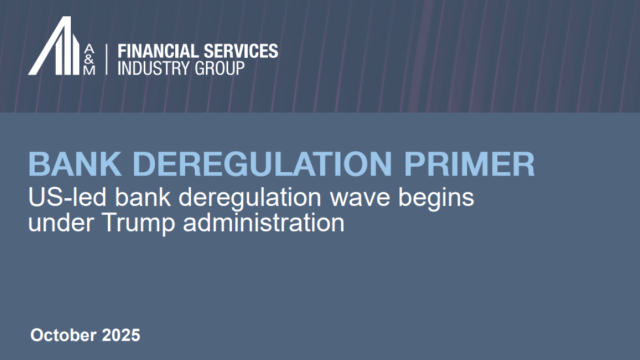Spanish banks prepare a take-off in profitability under a scenario charged with volatility and uncertainty
"The Spanish Banking Pulse Q4 2022"
This study analyzes the evolution of the top 10 Spanish banks in terms of growth, liquidity, efficiency, risk, profitability and solvency throughout 2022, highlighting the key performance indicators of the industry and scoring them according to KPIs related to each area of analysis. Alvarez & Marsal's ranking for large banks is headed by BBVA, while that of medium-sized banks is led by Kutxabank.
Additionally, the report includes an analysis of the Spanish banks in the stock market, a summary of profitability, productivity and efficiency ratios. Following the events of the last few weeks, we have also included an analysis of Spanish banks and major European countries on held-to-maturity (HTM) portfolios and deposit quality.
The report shows that, during 2022, the profitability (ROE) of banking stood at 8.1%, while in 2021 it was 6.3%. Spanish banking is still far from the double-digit profitability target, although it remains above the European average of 7.7%. The downward trend in the cost of risk also continues, at 9 basis points less than at the end of December 2021.
The non-performing loan (NPL) ratio for all entities has fallen once again to 3.12%. This is due to a drop in NPLs, by 17% in the last quarter of 2022, thanks to the sale of portfolios by the largest banks. Although coverage remains stable, NPLs are still high compared to the European average (1.8%). The entities with the highest level of NPLs are BBVA and Sabadell.
The industry’s solvency levels have decreased to 12.62% primarily due to the payment of dividends and share repurchase programs. In comparative terms, European banks still have higher levels of solvency, at around 15%. Spanish banks will have to measure their solvency and resilience levels comparative to European banks in the 2023 stress tests.
A&M's analysis shows that net interest income (NIM) is 1.07% higher than in the previous year. Here, the repricing of the EURIBOR, which has already overcome the negative range and is currently above 3%, is noticeable. In addition, the sector's operating income has remained stable at 1.7%.
The industry’s efficiency improved by 473 basis points over the previous year, to 50.45%, awaiting possible future inflationary pressures on costs. Bankinter is the only bank below the long-term target of 45%. Similarly, A&M’s report observes higher productivity per branch for all banks and highlights Santander as the bank that has improved this indicator the most (due to the closures of branches), followed by Bankinter. Productivity improvements are still to be reflected in banks such as Caixabank, which is currently developing a branch adjusting process.
Additional topics included in this edition of The Banking Pulse
The first new feature is a comparative analysis of the stock market valuation of Spanish banks. The latest increase in bank share prices appears to be driven by non-fundamental factors. Expectations of a more favorable regulatory and interest rate environment have helped to improve the stock status. In addition, the end of the pandemic and rising interest rates have led Spanish banks again to beat analysts’ estimations and bring solid stock market positions. In terms of multiples, most Spanish banks have experienced a recovery in their price/tangible book value (P/TBV) multiple following the pandemic.
The second further analysis is a summary of the profitability and productivity of Spanish banks:
- In terms of ratios per customer: BBVA and Bankinter show the best productivity and efficiency ratios among large and medium-sized banks respectively;
- In terms of ratios per employee: Sabadell and Bankinter have the best productivity and efficiency ratios among large and medium-sized banks respectively; and
- In terms of ratios per branch: Santander and Bankinter have the best productivity and efficiency ratios.
Thirdly, A&M has developed an analysis of Spanish banks and major European countries by their HTM portfolios and the quality of deposits. HTM debt values in Spain are similar to the EU average and Spanish banks hold a lower proportion of non-retail deposits than European banks. Italy has the highest proportion of HTM debt securities in total customer deposits, at 22.1%. Banks with the highest level of HTM debt over deposits do not have a relevant non-retail deposit base and banks with a relevant level of non-retail deposits do not have a relevant level of HTM debt over deposits, so no entities are in a worrying area.
According to Fernando de la Mora, Managing Director and Head of Alvarez & Marsal Spain and Portugal: "Spanish banks have improved profitability and NPL levels during 2022, while they have experienced a drop in solvency due to shareholder remuneration programs. This average profitability of Spanish banks is above that of European banks due to rising interest rates and the efforts made in areas such as digitalization. Additionally, as the banking sector is very sensitive to factors affecting the economy, we have included in this edition of "El Pulso" an analysis of its stock market performance with the help of our Valuations team. In the absence of recent uncertainty in the financial markets, we expect banking to continue its momentum of improving profitability and associated increases in shareholder remuneration."
The A&M Spanish Banking Pulse
The Spanish Banking Pulse ("El Pulso") is a half-yearly report that examines the 10 largest Spanish banks ("top 10") by their activities within Spain and highlights the main performance indicators of the Spanish banking sector. El Pulso's goal is to help the banking sector and board members stay abreast of industry trends.
All data used in this report have been obtained from public sources.
What we analyze: the 10 largest banks in Spain by business in the country
CaixaBank, BBVA, Santander, Sabadell, Bankinter, Abanca, Unicaja, Kutxabank, Ibercaja and Cajamar
If you would like a copy of the report, you can request it below.




